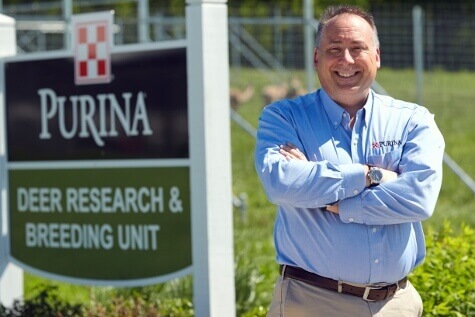
Nutritional Management of Penned Deer
Deer : Nutrition
Deer : Management
Nutritional management of penned deer goes beyond making sure the diet includes the required nutrients. While insuring nutrients are provided in the correct quantities to meet the productive needs of the animals at each life stage and season is important, analyzing hay & water, providing feed in a low stress environment, keeping deer at an appropriate body condition and controlling parasites are equally vital.
It is a given that deer should be provided the required nutrients for each stage of production to allow them to exhibit their genetic potential. These nutrients include protein, fat, carbohydrates, minerals and vitamins. The one nutrient that is often overlooked is water, and water is the most essential. Water needs to be clean fresh and always available.
Meeting the nutrient requirements is the first step in the nutritional management of the penned deer herd, but not the last. Following these six action steps below will help meet your deer’s nutritional needs.
It is a given that deer should be provided the required nutrients for each stage of production to allow them to exhibit their genetic potential. These nutrients include protein, fat, carbohydrates, minerals and vitamins. The one nutrient that is often overlooked is water, and water is the most essential. Water needs to be clean fresh and always available.
Minerals: More is not always better
A balanced nutrition approach is the goal. There are some nutrients that more are not always better, and this is often the case with minerals. An excess of one mineral can impact the absorption of another mineral. It is always good practice to have water and forages (pasture or hay) analyzed for minerals to understand if these sources of dietary minerals may supply high levels of a specific mineral that may be interfering with another mineral’s absorption causing a deficiency. Even if your area’s soils have minerals in appropriate concentrations and ratios, if hay is purchase from out of the area, this may impact the overall diet of the animals.Reduce digestive upset and stress
When feeding penned deer, proper feeding management helps reduce digestive upset and stress. The first step is to follow the directions of the feed being fed. While some feeds are labeled as complete feeds and contain adequate amounts of fiber for digestive health, many feeds are supplements and forage (pasture, hay, or browse) needs to be fed to provide enough dietary fiber. Make any dietary changes slowly over a 7-10-day period. This will allow the rumen microbes time to adjust to the new feed.Consistent feeding times and amounts
Feeding times and amounts should be consistent to keep intakes from fluctuating and reduce the chances of digestive upset. Additionally, when feeding in a trough, provide adequate feeder space to prevent stress from competition. While providing 12 inches of trough space for does may be adequate, feeding bucks with growing antlers may require significantly more linear trough space per deer. More trough space is always better to reduce stress.Body Condition Score: Bucks
Evaluating body condition is an important tool to assist in the nutritional management of the deer herd. A body condition score (BCS) is a visual assessment of the amount of muscle and fat deposited on the deer’s skeleton. The Purina Animal Nutrition Body Condition Scoring System2 uses a 1 to 5 scale, where BCS =1 is a deer that is Emaciated and a BCS = 5 is a deer that is Obese. An ideal BCS is between 3 and 3.5 and may need to be higher in bucks prior to the rut. Assessments should be done at least annually.Body Condition Score: Does
Does should be evaluated mid- to late-summer during the end of lactation to determine if does need to gain body condition prior to the breeding season. In mule deer, does with greater body condition prior to the breeding season had greater rates of twinning than those with lower BCS3. Additionally, does in good body condition during gestation produced heavier fawns and more fawns than does in poor body condition4. As noted, keeping does in good body condition supports reproduction, but getting does over conditioned has its own problems. In a study in red deer, when females had a BCS approaching 4, the hinds were 2.7 times more likely to have difficult births1. A good time to evaluate a buck’s body condition is after the rut. This allows time to change the buck’s diet to improve body condition before the next antler growing season.Parasite Control
Internal and external parasites rob the deer of nutrients that could be used for reproduction, growth or antler development. It is important to know what parasites are prevalent in your deer’s environment. Your herd veterinarian can assist in identifying the internal parasites that are present in a fecal sample and develop a parasite control program that matches the appropriate dewormer with the parasites present. The goal is to treat the parasites strategically. The goal of strategic parasite control is to treat deer that show symptoms, but not over treat so that the parasites become resistant to the medication.Meeting the nutrient requirements is the first step in the nutritional management of the penned deer herd, but not the last. Following these six action steps below will help meet your deer’s nutritional needs.
- Provide a balanced diet that meets the deer’s stage of production.
- Offer clean, fresh water always.
- Analyze hay and water routinely.
- Feed consistently with adequate feeder space.
- Utilize body condition scoring.
- Practice strategic deworming.



